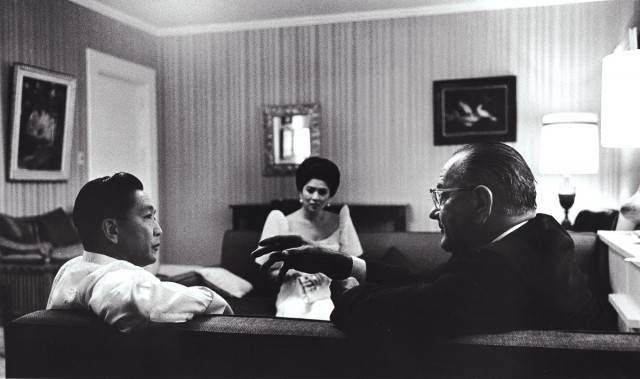
President Marcos of the Philippines (left) and his wife Imelda (center) in a meeting with US President Lyndon B. Johnson (right) in Manila in October 1966.
Ferdinand Marcos served as the 10th president of the Philippines from 1965 to 1986. Espousing an ideology of “constitutional authoritarianism” under the New Society Movement, he ruled as a dictator under martial law from 1972 until 1981, and kept most of his martial law powers until he was deposed in 1986. One of the most controversial leaders of the 20th century, Marcos’ rule was infamous for its corruption, extravagance and brutality.
Throughout his political career, Marcos claimed to have been the “most decorated war hero in the Philippines.” A number of his claims have been found to be false, with United States Army documents describing his wartime claims as “fraudulent” and “absurd.”
After the war, he became a lawyer, then served in the Philippine House of Representatives from 1949 to 1959 and the Philippine Senate from 1959 to 1965. He was elected the President of the Philippines in 1965, and presided over an economy that grew during the beginning and intermediate portion of his 20-year rule, but ended in the loss of livelihood, extreme poverty, and a crushing debt crisis. Marcos placed the Philippines under martial law on September 23, 1972, shortly before the end of his second term. The Constitution was revised, media outlets were silenced, and violence and oppression was used against the political opposition, Muslims, suspected communists, and ordinary citizens.
Before Marcos’s presidency, the Philippines was the second largest economy in Asia, behind only Japan. He pursued an aggressive program of infrastructure development funded by foreign debt, making him very popular throughout almost all of his first term and eventually making him the first and only President of the Third Philippine Republic to win a second term, although it would also trigger an inflationary crisis which would lead to social unrest in his second term, and would eventually lead to his declaration of martial law in 1972. Martial law was ratified in 1973 through a fraudulent referendum.
After being elected for a third term in the 1981 Philippine presidential election, Marcos’s popularity suffered greatly due to the economic collapse which began in early 1983, and the public outrage over the assassination of opposition leader Senator Benigno “Ninoy” Aquino Jr. later that year. This discontent, the resulting resurgence of the opposition in the 1984 Philippine parliamentary election, and the discovery of documents exposing his financial accounts and false war records, led Marcos to call the snap election of 1986. Allegations of mass cheating, political turmoil, and human rights abuses led to the People Power Revolution of February 1986, which removed him from power. To avoid what could have been a military confrontation in Manila between pro- and anti-Marcos troops, Marcos was advised by US President Ronald Reagan through Senator Paul Laxalt to “cut and cut cleanly.” Marcos then fled with his family to Hawaii. He was succeeded as president by Aquino’s widow, Corazon “Cory” Aquino.

Ferdinand Marcos served as the 10th president of the Philippines from 1965 to 1986. Espousing an ideology of “constitutional authoritarianism” under the New Society Movement, he ruled as a dictator under martial law from 1972 until 1981, and kept most of his martial law powers until he was deposed in 1986. One of the most controversial leaders of the 20th century, Marcos’ rule was infamous for its corruption, extravagance and brutality.
Throughout his political career, Marcos claimed to have been the “most decorated war hero in the Philippines.” A number of his claims have been found to be false, with United States Army documents describing his wartime claims as “fraudulent” and “absurd.”
After the war, he became a lawyer, then served in the Philippine House of Representatives from 1949 to 1959 and the Philippine Senate from 1959 to 1965. He was elected the President of the Philippines in 1965, and presided over an economy that grew during the beginning and intermediate portion of his 20-year rule, but ended in the loss of livelihood, extreme poverty, and a crushing debt crisis. Marcos placed the Philippines under martial law on September 23, 1972, shortly before the end of his second term. The Constitution was revised, media outlets were silenced, and violence and oppression was used against the political opposition, Muslims, suspected communists, and ordinary citizens.
Before Marcos’s presidency, the Philippines was the second largest economy in Asia, behind only Japan. He pursued an aggressive program of infrastructure development funded by foreign debt, making him very popular throughout almost all of his first term and eventually making him the first and only President of the Third Philippine Republic to win a second term, although it would also trigger an inflationary crisis which would lead to social unrest in his second term, and would eventually lead to his declaration of martial law in 1972. Martial law was ratified in 1973 through a fraudulent referendum.
After being elected for a third term in the 1981 Philippine presidential election, Marcos’s popularity suffered greatly due to the economic collapse which began in early 1983, and the public outrage over the assassination of opposition leader Senator Benigno “Ninoy” Aquino Jr. later that year. This discontent, the resulting resurgence of the opposition in the 1984 Philippine parliamentary election, and the discovery of documents exposing his financial accounts and false war records, led Marcos to call the snap election of 1986. Allegations of mass cheating, political turmoil, and human rights abuses led to the People Power Revolution of February 1986, which removed him from power. To avoid what could have been a military confrontation in Manila between pro- and anti-Marcos troops, Marcos was advised by US President Ronald Reagan through Senator Paul Laxalt to “cut and cut cleanly.” Marcos then fled with his family to Hawaii. He was succeeded as president by Aquino’s widow, Corazon “Cory” Aquino.


